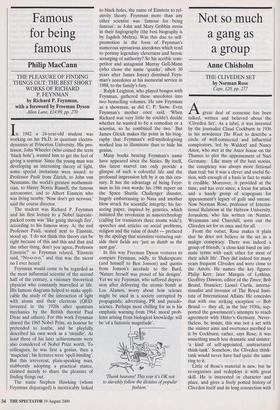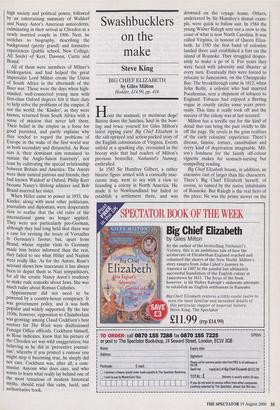Not so much a gang as a group
Anne Chisholm
THE CLIVEDEN SET by Norman Rose Cape, £20, pp. 277 Agreat deal of nonsense has been talked, written and believed about the `Cliveden Set'. As a label, it was invented by the journalist Claud Cockburn in 1936 in his newsletter The Week to describe a circle of well-connected and influential conspirators, led by Waldorf and Nancy Astor, who met at the Astor house on the Thames to plot the appeasement of Nazi Germany. Like many of the best stories, the conspiracy was always more fictional than real: but it was a clever and useful fic- tion, with enough of a basis in fact to make it credible. Moreover, it provided at the time, and has ever since, a focus for attack and a handy group of scapegoats for appeasement's legacy of guilt and unease. Now Norman Rose, professor of Interna- tional Relations at the Hebrew University, Jerusalem, who has written on Namier, Weizmann and Churchill, sorts out the Cliveden set for us once and for all.
From the outset, Rose makes it plain that he does not believe in the set as a malign conspiracy. There was indeed a group of friends, 'a close-knit band on inti- mate terms with each other for most of their adult life'. They did indeed for many years frequent Cliveden and were close to the Astors. He names the key figures: Philip Kerr, later Marquis of Lothian; Geoffrey Dawson, editor of the Times; Bob Brand, financier; Lionel Curtis, interna- tionalist and inventor of The Royal Insti- tute of International Affairs. He concedes that with one striking exception — Bob Brand — they all, in the late 1930s, sup- ported the government's attempts to reach agreement with Hitler's Germany. Never- theless, he insists, this was not a set with the sinister aims and overtones ascribed to it by Cockburn; rather, says Rose, it was something much less dramatic and sinister: `a kind of self-appointed, unstructured think-tank'. Somehow, the Cliveden think- tank would never have had quite the same ring to it.
Little of Rose's material is new, but he re-organises and redeploys it with great skill. He is interested in character and place, and gives a lively potted history of Cliveden itself and its long connection with high society and political power, followed by an entertaining summary of Waldorf and Nancy Astor's American antecedents, culminating in their arrival at Cliveden as a newly married couple in 1906. Next, he switches to biography, describing the background (pretty grand) and formative experiences (public school, New College, All Souls) of Kerr, Dawson, Curtis and Brand.
All of them were members of Milner's kindergarten, and had helped the great imperialist Lord Milner create the Union of South Africa in the aftermath of the Boer war. Those were the days when high- minded, well-connected young men with first-class Oxford degrees felt it their duty to help solve the problems of the empire, if not the world; the 'Kinder', as they were known, returned from South Africa with a sense of mission that never left them. Their belief in the empire as a force for good persisted, and partly explains why they tended to regard the problems of Europe in the wake of the first world war as both secondary and distasteful. As Rose sees it, their dominant aim remained 'to sustain the Anglo-Saxon fraternity', not least by cultivating the special relationship between Britain and America. The Astors were their natural patrons and friends; they had known Waldorf at Oxford, Philip Kerr became Nancy's lifelong admirer and Bob Brand married her sister.
When Hitler came to power in 1933, the Kinder, along with most other politicians, journalists and diplomats, were desperately slow to realise that the old rules of the international game no longer applied. They were not particularly pro-German, although they had long held that there was a case for revising the treaty of Versailles in Germany's favour; but, apart from Brand, whose regular visits to Germany made him better informed than the rest, they failed to see what Hitler and Nazism were really like. As for the Astors, Rose's account shows how inaccurate it has always been to depict them as Nazi sympathisers, for all the erratic Nancy Astor's tendency to make rude remarks about Jews. She was much ruder about Roman Catholics.
Appeasement did not need to be powered by a country-house conspiracy. It was government policy, and it was both Popular and widely supported. By the late 1930s, however, opposition to Chamberlain was growing: among Claud Cockburn's best sources for The Week were disillusioned Foreign Office officials. Cockburn himself, as Rose indicates, knew that his picture of the Cliveden set was wild exaggeration; but believing as he did in 'preventive journal- ism', whereby if you printed a rumour you might stop it becoming true, he simply did not care. Cockburn was, after all, a com- munist. Anyone who does care, and who wants to learn what really lay behind one of the most tenacious of modern historical myths, should read this calm, lucid, and authoritative book.



























































 Previous page
Previous page